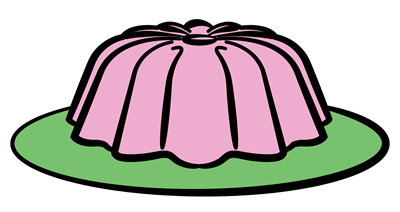As expected, you guys all did great at the quiz! But of course you would. We are all vintage recipe fanatics here.
I don’t even need to share the answers with you, not really. All the correct answers are in the comments. But I will anyway, because I had a whole lot of fun writing this. What can I say? I love this stuff.
So, here we go:
1. What is an alligator pear?
An alligator pear is a nickname for an avocado. And now that you’ve read that, you are probably nodding your head in agreement. The shape of the avocado does really look like the scaly head of an alligator.
I think the first time I came across it was in this recipe from 1934, Double Pear Salad.
I don’t come across this term as much as I would like to in vintage recipes, since this is really a very old term. If you are just dying to see it in the wild, you will most likely come across it in recipes that date before the 1930’s.
2. Name one flavor of Jell-O’s short-lived savory “For Salads” gelatin line.
Mixed Vegetable, Celery, Seasoned Tomato and Italian Salad.
I am actually really sad that these gelatin flavors didn’t stick around longer. They would have made my job a lot easier. And I would have really liked to feed them to Tom.
3. How do you get onion juice?
You get onion juice by “scraping” an onion or running an onion over a grater. To scrape, take the non-sharp side of your knife and run it down the cut side of a freshly halved onion. The resulting milky onion goo is onion juice. What is it used for? Mostly making aspics and other gelatin salads, though sometimes it is used to give other mid-century dishes a light, juicy kiss of onion.
I have also read and been told that they used to sell onion juice in a bottle in the store. Oh, what a time they lived in!
4. How hot is the “moderate” oven setting?
As far as I am able to figure out, here are the somewhat accurate temperature equivalents for older recipes:
Slow Oven – 275 degrees to 325 degrees
Moderate Oven – 350 degrees
Moderately Hot Oven – 375 to 400 degrees
Hot Oven – 425 degrees and up
The only one I am really sure about is “moderate”. 350 degrees is always a good assumption. The other ones can vary a lot. I’ve seen a “hot” oven be 400 degrees and a “moderately hot” be 425 degrees, so use your best guess for those!
5. What are acceptable mid-century food garnishes?
Acceptable garnishes are olives:
Parsley and Greens:
And whatever is in the dish, but cut up and made into interesting shapes:
6. What do you add to prepackaged gelatin dessert to make a savory salad?
The real answer to this is: Nothing. Once you start out with fruit flavored gelatin, there is really no going back. But, mid-century cooking used a lot of vinegar, lemon juice, onions, cabbage and olives to try and prove that wrong.
They did not succeed.
7. What is in Under The Sea Salad?
Under the Sea Salad is a delightful salad published by Jell-O that is made of lime gelatin, cream cheese and pears. The original started out with ginger and vinegar, but over time they dropped the vinegar and stared using cinnamon instead of ginger. It’s also my favorite gelatin salad.
This image is actually from Yesterdish. I had one, but it wasn’t as pretty as this one. Now I am on a mission to get this exact cookbook!
8. What is in California Dip?
California dip is just a package of Lipton Onion Soup mix and a carton of sour cream. It is also partially responsible for the evolution of cocktail party appetizers, and also America’s love affair with chips and dip.
9. What is Spry?
Spry is the product name of a solid at room temperature cooking shortening that was sold in a tub. Think Crisco. In fact, it was an attempt by Lever to steal the market from Crisco, which it did through aggressive marketing and it’s loveable mascot, Aunt Jenny. It was very popular in the late 1930’s and 1940’s, but eventually sales took a turn and it was discontinued in the 1970’s.
10. What does the word “salad” mean?
“Salad” in mid-century cooking means anything that you serve before or next to or instead of meat that contains or resembles fruit or a vegetable. Or if it has no fruit or vegetable, if you can serve it on a lettuce leaf you are good. It’s still a salad.
New Three-Bean Salad.
Sea Breeze “Salad”. As Tom said, “Really good, but this is totally a dessert.”
11. How long should seafood be cooked?
I’m not sure if it is that our thermometers are more accurate, or if our ovens run hotter, or if we as a culture have completely changed our definition of “done”, but as a general rule mid-century seafood and fish is usually cooked at least twice as long as it needs to be. Sometimes four times.
12. How do you make basic white sauce?
Basic white sauce is just milk thickened with flour that has been cooked in butter (a roux), and it was a staple of mid-century cooking. Every cook was expected to know how to make, from memory, the thickness of white sauce appropriate for a certain recipe, like a thin white sauce for cream soup or a thick white sauce for making a pot pie.
If you need more info, I did a quick tutorial on the blog a couple of years ago. You can see it here!
13. What is PET milk?
This has to be one of the more horrified questions that I get on the recipes I post. No, PET milk is not made from pets, nor is it meant for pets. It is just a brand name of canned evaporated milk and dried milk products that had a great advertising campaign and were heavily involved in radio shows. You can still buy it today!
So, that’s it for the questions! How did you do?
I hope you had a good time with these, because I sure had a good time putting this little quiz together! And a big thank you to my friend Carolyn, who’s bright idea it was to do this in the first place!

























PET milk is the best tasting of the bunch.
Usually more expensive though.
We had onion juice in the 90s! It was a small bottle, about the size of a small vanilla extract and we used it for seasoning. Don’t confuse those bottles!
These pics…wow.
This was fun!
I remember onion juice! Boy, I sure used to hate the nights my Mom made the pear and lime jello, but then again, I just don’t like pears!
Funny story about alligator pears…my husband worked in the produce department of a grocery store while he was in college during the 80s. He said a lady came in once and asked where the alligator pears were. He and the rest of the staff were all over the store, trying to find what she meant, until the lady walked past the avocados and said, “Here they are!”
Thanks for the fun quiz!
I scored a 10! (I don’t know cooking temps and couldn’t remember Under the Sea, even though I read that post).
I loved reading old recipe books and get such a kick out of you making them and making Tom try them!
You can still buy onion juice here in Texas. I keep it on hand in case I run out of onions. In a pinch it will “do” in quacamole!
So much fun! Though I always think, “No wonder people weighed less in the 40s and 50s…who would want to eat much of some of these salads!”